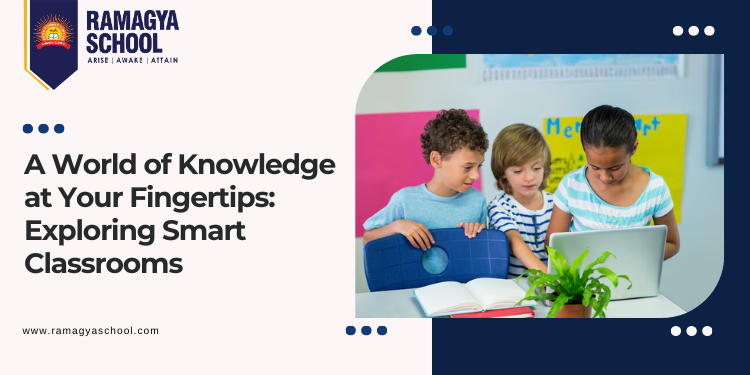Today’s rapidly changing educational landscape Classrooms have changed. The classic chalkboards and textbooks are replaced by interactive whiteboards, digital devices, and also online sources. This shift is driven by the concept of smart classrooms in which technology plays an important role in enhancing the learning experience of both students and teachers.
What Exactly are Smart Classrooms?
Imagine attending a class where the walls aren’t covered with poster boards; they are also outfitted with touchscreens that present educational content with the flick of your finger. This is the essence of a smart classroom. It goes beyond traditional teaching methods by using technology to enable more communication, collaboration, and understanding between students and teachers.
Key Components of Smart Classrooms
- Interactive Whiteboards: They are electronic boards which display content from computers. They allow teachers to engage directly in the material by using styluses or touch gestures. It helps make learning more fun and helps students participate.
- Digital devices (Tablets and laptops): Students and teachers can use these devices to access online books, apps for education and other online sources. They allow customized learning experiences that are tailored to the specific needs of each student and their learning preferences.
- Internet connectivity: High-speed internet access is vital in modern classrooms. It facilitates seamless communication, online access to educational resources, and collaboration tools that bring students and educators outside of the classroom.
- Education Software and Apps: Specific software applications offer interactive lessons, simulations and assessments in a variety of subject areas. These programs cater to various stages of learning and can help to reinforce concepts with multimedia and interactive exercises.
Benefits of Smart Classrooms:
- Enhanced Learning Experiences
- Engage: Interactive lessons using multimedia content grab students’ interest and make learning enjoyable and relevant.
- Customization: Flexible learning systems allow you to adjust the pace and method of instruction to meet the individual’s needs and preferences.
- Accessibility to resource: Students have access to a wide range of educational resources, including videos, ebooks and simulations that help their knowledge of complicated issues.
- Improved Teaching Methods
- Efficient instruction: Instructors can develop interactive lesson plans that incorporate multimedia content that meets different learning styles, improving retention and comprehension.
- Real-Time Assessment: Digital tools offer immediate feedback on the progress of students which allows teachers to spot areas of improvement and adapt the teaching methods accordingly.
- Collaboration: Online discussion boards and virtual classrooms allow collaboration between students and teachers encouraging collaboration and communication skills.
- Administrative Efficiency
- Data-Driven Information: Analytics tools can provide important insights into the trends in student performance and help educators make informed choices to help students achieve achievement.
- Resource Management: These digital tools simplify administration tasks like monitoring attendance, grading and communicating with parents, reducing time and increasing efficiency.
Challenges and Solutions
Challenges:
- Cost: Implementing and maintaining intelligent classroom technology is expensive for schools, particularly those with a limited budget.
- Teachers Training: Educators might require professional training and development in order to integrate technology effectively into their teaching methods and reap the maximum educational benefits.
- Digital Divide: Inequalities in access to tech for students and communities can increase the gap in education and hinder equitable learning opportunities.
Solutions:
- Financial Support: Look for partnerships or grants as well as government initiatives that offer financial aid to schools that want to adopt technology.
- Professional Development: Continuous training, support and assistance to teachers in order to help them build confidence and mastery in the use of educational technology effectively.
- Equity initiatives: Create programs in order to provide equal access to technology equipment and Internet connectivity for all students, and bridge that digital gap.
Future Directions of Smart Classrooms
The future of smart boards for classrooms has better possibilities:
- Artificial Intelligence (AI): AI-powered educational tools will give students individualized instruction, adaptive learning pathways as well as real-time assessment of student performance that are based on analytics of data.
- Virtual Reality (VR) and Augmented Reality (AR): Immersive experiences can let students explore virtual worlds and interact with simulations, which bring learning to life in exciting and exciting ways.
- Internet of Things (IoT): Connected devices in smart classrooms can automate the tasks, monitor student participation, and alter learning environments in real-time based on results and feedback.
Conclusion
Smart Boards for classrooms are a major change in the field of education, harnessing technology to create vibrant and interactive learning environments that help prepare learners for the challenges of the 21st-century. Through embracing the latest innovations teachers can foster imagination, critical thinking and a sense of collaboration with students, and equip students with the essential abilities needed for the future.
In the years ahead, as we develop and change as we continue to evolve and adapt, the smart classroom will have a crucial function in shaping our future education. They will make learning more accessible, enjoyable and relevant for every student.
Let’s take advantage of the possibilities of smart classrooms and unlock the vast world of possibilities and knowledge right in front of us.





